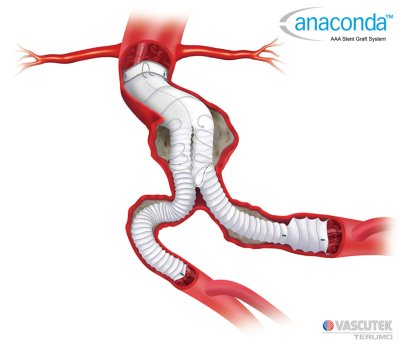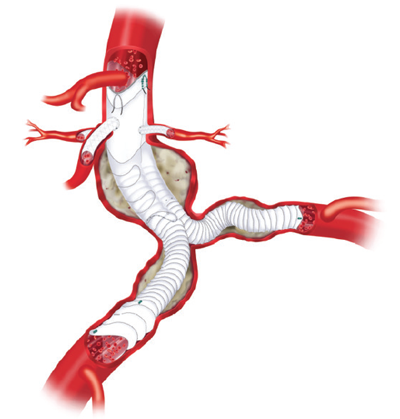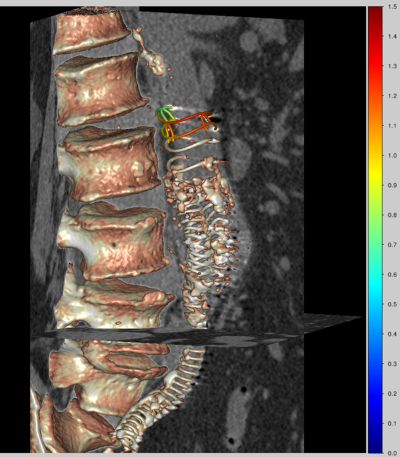Improving the Durability of Endovascular Aortic Stent grafts (IDEAS)
Organization:
Funded by: | Unrestricted research grant by Vascutek Ltd. |
PhD: | Maaike Koenrades |
Supervisors: |
|
Collaboration: |
|
Description:
Clinical background
To prevent rupture of aortic aneurysms (locally dilated and weakened walls), a stent graft (metal wire-frame sealed with synthetics) can be placed inside the aorta. This procedure is referred to as endovascular aortic aneurysm repair (EVAR) (Figure 1). Sealing and fixation of the stent graft to the aortic wall is crucial for successful outcome and failure hereof is often a reason for reintervention. Reinterventions are a burden for EVAR, both for the well-being of patients and for health care costs. The pulsatile blood flow challenges the sealing and fixation, yet knowledge on the interaction with the stent graft is limited.
Figure 1. Schematic representation of an EVAR intervention in an infra-renal abdominal aortic aneurysm. Reproduced with permission from Droc, I., B. Calinescu, and D. Raithel, Abdominal Aortic Aneurysms - Actual Therapeutic Strategies. 2012: INTECH Open Access Publisher.
Objective
The objective of this research is to validate motion estimation algorithms applied to dynamic CT scans and to investigate motion and conformational changes of aortic vessels and implanted stent grafts during patient follow-up. With this research, we aim to identify parameters that aid the prediction of stent graft failure. This would allow for patient specific follow-up schemes and early identification of problems. In addition, stent graft manufacturers may optimize their designs based on this knowledge.
About the project
ECG-gated computed tomography (CT) enables motion analysis of implanted stent grafts. In 2011, Klein et al. developed algorithms to estimate stent graft motion by means of segmentation and image registration. In this project, Klein’s method is further developed, validated and applied to clinical data in order to investigate the dynamic behavior of stent grafts and their interaction with aortic wall during the cardiac cycle and over time. In collaboration with the Medisch Spectrum Twente hospital, the LSPEAS trial is conducted. Patients included is the trial receive ECG-gated CT scans at standardized time points during follow-up. Figure 4 provides an example of motion estimation of the proximal dual ring of the Anaconda™ stent graft. In March 2017, the LSPEAS F-EVAR national multicenter trial was launched. Patients with complex abdominal aneurysms who undergo fenestrated EVAR (Figure 3) are included. Motion and configurational changes of stented branch vessels are investigated.

Figure 2. A representation of the deployed Anaconda™ AAA stent graft system (Vascutek, Inchinnan, Scotland, UK) for the treatment of infrarenal abdominal aortic aneurysm. (Image courtesy of Vascutek Ltd.)

Figure 3. A representation of a deployed Fenestrated Anaconda™ Custom AAA Stent Graft System (Vascutek, Inchinnan, Scotland, UK) for the treatment of juxtarenal and pararenal aortic aneurysmal disease. In this case, the coeliac trunk is accommodated in the anterior valley of the device. (Image courtesy of Vascutek Ltd.)

Figure 4. Example of motion estimation of the proximal dual ring of the Anaconda™ stent graft from an ECG-gated CT scan of a patient. Colors represent three-dimensional displacement of points during the cardiac cycle.
Publications:
- Conference papers:
Validation of an image registration and segmentation method to measure stent graft motion on ECG-gated CT using a physical dynamic stent graft model. 2017. http://dx.doi.org/10.1117/12.2254262
